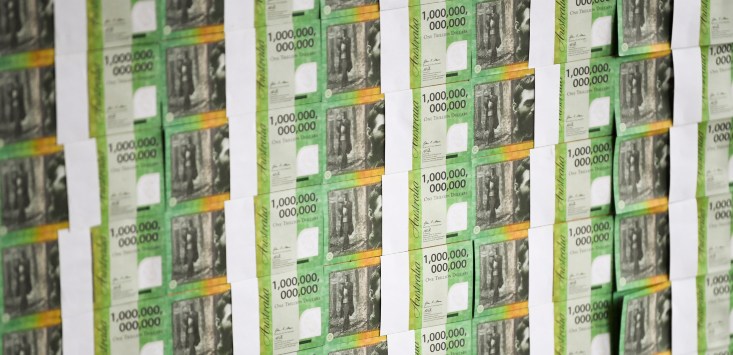
Independent Member for Hughes Craig Kelly brings a pallet of fake trillion dollar notes to a press conference at Parliament House in Canberra, Tuesday, May 11, 2021. Source: AAP Image/Lukas Coch
If the government can’t win an election with this cash splash, it should give up politics. This is the biggest budget splurge outside an economic crisis in history, with two $100 billion deficits in a row coming up despite unemployment expected to fall below 5%.
The deficit will still be over $50 billion in 2024-25, making this the first budget in history designed to buy two elections in a row. Josh Frydenberg has more than lived up to his commitment to abandon the return to fiscal discipline and keep spending money to push unemployment down as far as possible.
If we want to suspend political disbelief for a moment, you can see a policy justification for Josh Frydenberg’s determination to keep firing the cash cannons long after we’ve returned to our pre-pandemic levels of joblessness. The government’s forecasts for the Wage Price Index will barely shift even as unemployment reaches 4.5%: 1.5% growth next year, 2.25% in 2022-23, 2.5% in 2023-24, and 2.75% the following year.
That means minimal real wage rises for Australian workers over the forward estimates. That’s the sign of a broken labour market, in which workers lack the power to exploit low unemployment to demand better pay. But it also provides a political justification for the government to keep the fiscal taps open well into the mid-2020s.
The question then becomes about the quality of the spend: are taxpayers getting value for money from the huge debt the government is running up for them? The areas targeted are notoriously difficult to get right: aged care has proven problematic for multiple governments (which have all nickel-and-dimed the sector); mental health, which has endured multiple injections of funding for more than a decade; $1.9 billion to fix the vaccine rollout debacle; more money for first home buyers which will likely flow straight through to home owners.
For a government that has gained a reputation for being all about the announcement while going missing for the delivery, the only real political risk is that voters work out by the next election (watch the stories about a 2021 election return in coming weeks) that the big spending isn’t necessarily being delivered on the ground.
But the political damage is primarily on Labor. This is the kind of budget Labor would never deliver because it knows it wouldn’t be allowed to get away with it — pumping 5% of GDP into deficit spending when unemployment is already at 5.6%. It can only critique the quality of the spending — necessarily a long-term political project — or tell voters that if they want the real thing when it comes to better social services they should come to Labor.
The longer-term political question, one that goes beyond the next election or two and beyond the current prime minister and treasurer, is what will embracing big government do to the Liberal Party?
For decades, the Liberals have preached fiscal virtue and insisted they were the true party of fiscal discipline; that they alone understood that government money was taxpayer money to be used wisely.
They never practised what they preached: the Coalition has long been the big taxing, big-spending party of government, consistently delivering high levels of spending and tax, and the biggest rorter of taxpayer money. Now it has embraced the truth of who it really is: the Liberals are all about big spending and big government.
How comfortable are the remaining neoliberals of this government with their new status as the party of government intervention? Probably just fine if it gets them reelected.
This article was first published by Crikey.
Handpicked for you

Budget 2021: Government procurement for SMEs in focus



COMMENTS
SmartCompany is committed to hosting lively discussions. Help us keep the conversation useful, interesting and welcoming. We aim to publish comments quickly in the interest of promoting robust conversation, but we’re a small team and we deploy filters to protect against legal risk. Occasionally your comment may be held up while it is being reviewed, but we’re working as fast as we can to keep the conversation rolling.
The SmartCompany comment section is members-only content. Please subscribe to leave a comment.
The SmartCompany comment section is members-only content. Please login to leave a comment.